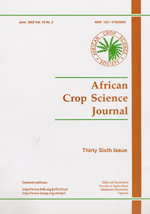
|
African Crop Science Journal
African Crop Science Society
ISSN: 1021-9730
EISSN: 1021-9730
Vol. 25, No. 2, 2017, pp. 221-235
|
 Bioline Code: cs17016
Bioline Code: cs17016
Full paper language: English
Document type: Research Article
Document available free of charge
|
|
|
African Crop Science Journal, Vol. 25, No. 2, 2017, pp. 221-235
| fr |
CONSTRAINTS TO CROP PRODUCTION AND ADAPTATION STRATEGIES OF SMALLHOLDER FARMERS IN SEMI-ARID CENTRAL AND WESTERN ZIMBABWE
MAKUVARO, V.; WALKER, S.; MUNODAWAFA, A.; CHAGONDA, I.; MASERE, P.; MUREWI, C. & MUBAYA, C.
Résumé
La productivité agricole des petits paysans dans les pays en développement est limitéé par de diverses contraintes biotiques et abiotiques. Ils ont, cependant développé des strategies adaptatives pour faire face à ces contraintes, consolidant ainsi leur resilience aux divers stress. L’objectif de cette étude était d’établir les contraintes de la production agricole auxquelles font face les petits paysans dans les basses regions semi-arides de Gweru et Lupane au Zimbawé, ainsi que les strategies d’adaptation utilisées. Des discussions de groupes et des entretiens structurés ont été utlisés pour la collecte des données. La grande variabilité de pluies (CV = 0, 30) a reçu le rang le plus élevé (le plus important); suivie de la pénurie générale d’intrants, selon les discussions de groupes. Les paysans se sont adaptés aux variabilitées de pluies à travers le choix des cultures et des dates de semis, en ajustant les niveaux d’intrants (engrais en particulier) qu’ils utilisaient, ainsi qu’en se recourant aux espaces de production avec une nappe phréatique affleurant la surface du sol. Soixante pourcent des paysans dans les deux zones communales rencontraient la pénurie des semences, alors que la penurie en engrais était rapportée par 75 et 30% des paysans de la basse Gweru et Lupane, respectivement. La main d’oeuvre a été une contrainte majeure pour 65 et 20% des paysans dans les deux regions, respectivement; tandis que le manque de traction animale a affecté 50 et 25% de producteurs. Environ 50% de producteurs au Lupane ont rapporté le problème de destruction des plantes par les éléphants. La pendemie du VIH/SIDA et la pauvreté des sols ont aussi été rapportées pendant les discussions de groupes. Les producteurs se sont adaptés au manque d’intrants en loyant et en partageant leurs ressources. Ils ont réduit les dommages causés par les éléphants en récoltant de façon précoce leur cultures. Les effets du VIH/SIDA ont affaibli la force de la main d’oeuvre et certaines commautés dans les milieux d’étude ont aidé les familles affectées en travaillant dans leurs champs.
Mots Clés
Engrais; VIH; main d’oeuvre; semences
|
| |
| en |
CONSTRAINTS TO CROP PRODUCTION AND ADAPTATION STRATEGIES OF SMALLHOLDER FARMERS IN SEMI-ARID CENTRAL AND WESTERN ZIMBABWE
MAKUVARO, V.; WALKER, S.; MUNODAWAFA, A.; CHAGONDA, I.; MASERE, P.; MUREWI, C. & MUBAYA, C.
Abstract
Smallholder farmer agricultural productivity in developing countries is limited by diverse biotic and abiotic constraints. They have, however, developed adaptive strategies to cope with some of these constraints, thereby strengthening their resilience to various stresses. The objective of this study was to establish crop production constraints faced by smallholder farmers in semi-arid Lower Gweru and Lupane areas of Zimbabwe, as well as coping and adaptation strategies used. Focus group discussions and structured interviews were used to collect data. High rainfall variability (CV = 0.30) had the highest ranking (most important), followed by shortage of inputs collectively, from focus group discussions. Farmers adapted to rainfall variability mostly through choice of crop and planting dates, adjusting the levels of inputs (fertiliser in particular) they used, as well as by resorting to cropping in areas with a high water table. Sixty percent of the farmers in both communal areas experienced shortage of planting seed, while shortage of fertiliser was reported by 75 and 30% of the farmers in Lower Gweru and Lupane, respectively. Labour was a major constraint to 65 and 20% of the farmers in both locations, respectively; while draft power shortage affected 50 and 25% of the farmers. About 50% of the farmers in Lupane reported the problem of crop damage by elephants. The HIV and AIDs pandemic and poor soils were also reported during focus group discussions. Farmers coped with input shortages by hiring and sharing resources. They reduced damage from elephants by harvesting their crops early. The effect of HIV/AIDs weakened the labour force and some communities in the study areas helped affected families by working in their fields.
Keywords
Fertilisers; HIV; labour; seeds
|
| |
© Copyright 2017 - African Crop Science Society
|
|
